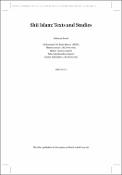Options
Imāmī Thought in Iran during the Ilkhanid Period: The Ḥimṣī Rāzī Family. With an editio princeps of Mishkāt al-yaqīn fī uṣūl al-dīn by Jamāl al-Dīn ʿAlī b. Maḥmūd al-Ḥimṣī al-Rāzī
Date
2025
Author(s)
Abstract
Scholars studying the development of Imāmī doctrinal thought are confronted with a lack of sources. Many pertinent works by Imāmī thinkers who lived in the various centers of Shīʿī learning in Iraq, Iran, and the historical region of Syria between the lifetimes of al-Sharīf al-Murtaḍā (d. 436/1044) and Naṣīr al-Dīn al-Ṭūsī (d. 672/1274) have not come down to us. Whereas al-Ṭūsī’s doctrinal works introduced Avicennan terminology and selected Avicennan concepts into Imāmī kalām, Imāmī theologians of the late fifth [eleventh] and sixth [twelfth] centuries were torn between the doctrines of the Bahshamites, their doctrinal alternatives (especially the notions of Abū l-Ḥusayn al-Baṣrī and his followers), and what were perceived as the more authentic theological views of the imams. Muʿtazilite thought, Avicennan notions, and the quest to return to the early doctrines of the imams continued to constitute the principal parameters of Imāmī theological thought over the following centuries. One way to overcome the gaps in our knowledge of Imāmī intellectual history is to consult documentary material that is primarily preserved in the manuscript tradition. Ownership statements, authorial and scribal colophons, collation notes, taʿlīqāt, and ḥawāshī, as well as the rich ijāza literature, provide extensive information about the circles of Imāmī scholarship during those centuries. The present study, focussing on the Ḥimṣī Rāzī family, which flourished in Iran during the seventh [thirteenth] and eighth [fourteenth] centuries, aims to showcase what can be achieved by gathering and piecing together relevant paratextual material from manuscript collections in German, Iranian and Turkish libraries. This evidence, together with information gleaned from the relevant biobibliographical and historiographical literature, provides deeper insights into the history of the family and the scholarly and doctrinal profiles of its members. The study is complemented by editiones principes of selected works by members of the Ḥimṣī Rāzī family—namely, the Mishkāt al-yaqīn, a note on istiḥālat ittiḥād al-bāriʾ maʿa l-makhlūqāt, and the introductions to Kashf al-maʿāqid, al-Amālī al-ʿirāqiyya, and al-Maṭālib al-qudsiyya, and a facsimile edition of the Talkhīṣ al-maqāṣid.
Description
Hassan Ansari and Sabine Schmidtke, in collaboration with Hamid Ataei Nazari, Imāmī Thought in Iran during the Ilkhanid Period: The Ḥimṣī Rāzī Family. With an editio princeps of Mishkāt al-yaqīn fī uṣūl al-dīn by Jamāl al-Dīn ʿAlī b. Maḥmūd al-Ḥimṣī al-Rāzī, Leiden: Brill, 2025
File(s)

Loading...
Name
Prelims and introduction.pdf
Size
261.54 KB
Format
Adobe PDF
Checksum (MD5)
43a78b333fae5d4f1c252a9e87b946c5
Loading...
Name
cover himsi Razi final.jpg
Size
1.5 MB
Format
JPEG
Checksum (MD5)
b547395addfd1da4b34a35ddf78aac52